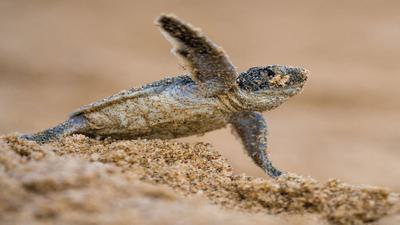Whether marine turtles are born male or female is dependent on the temperature of their nest during incubation. As global temperatures rise, scientists have found that the sand around the Red Sea is now warm enough to cause hatchlings in the area to be born almost entirely female, threatening the future survival of the region’s sea turtle population.
The region is home to five out of the world’s seven species of sea turtles, including endangered green turtles and critically endangered hawksbill turtles.
Scientists estimate that sea turtle nests need to be around 29.2 degrees Celsius (84.6 degrees Fahrenheit) to produce a 50:50 sex ratio as embryos develop in the eggs. Above that temperature, embryos predominantly become female. According to the new research, published in the journal Conservation Science and Practice, sand temperatures along the Red Sea exceeded the 29.2-degree threshold at all but one of the scientists’ study sites in the Red Sea. A few sites measured as high as 36 degrees C — nearly 97 degrees F.
The findings follow similar patterns in sea turtle populations in other parts of the world. In Florida, sea turtle hatchlings were born 100 percent female in seven out of the past 10 years. In the three years that did produce males, they only made up 10 to 20 percent of the new brood. On Australia’s Raine Island, the biggest green turtle nesting ground in the Pacific Ocean, the ratio of male to female turtle hatchlings in 2018 was 116:1.
“Marine turtles have survived since the late Triassic period and have adapted to past climatic shifts,” Lyndsey Tanabe, a graduate student at King Abdullah University of Science & Technology (KAUST) and lead author of the new study, said in a statement. “The current rate of anthropogenic-driven temperature change is unprecedented.”



